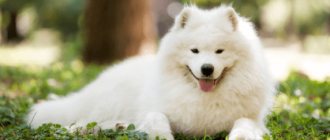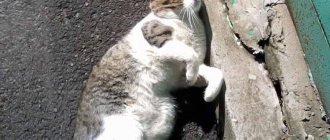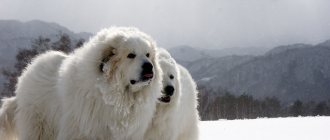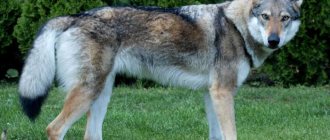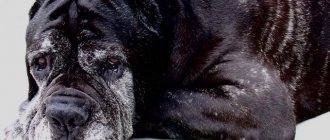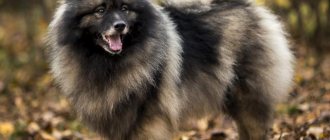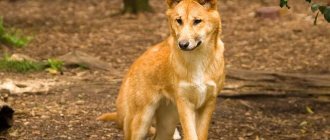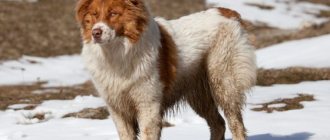The Samoyed Laika or Samoyed is a snow-white, fluffy dog whose homeland is the north. She has natural beauty and a friendly personality.
The dog has light thick fur, black eyes and a proportional build.
Since ancient times, Samoyeds have helped people survive in the harsh conditions of the server. At the same time, they were distinguished by intelligence, endurance and obedience.
Now he is a family dog, an excellent watchman and companion.
In this article we will talk about why Samoyeds are called that, what features they have and who such pets are suitable for.
origin of name
There are several versions of why this breed is called that.
Some experts believe that the origin of the name comes from the server people living in Russia. In ancient times, the name sounded exactly like that - Samoyeds. The modern name of the nationality is Nenets.
To be more precise, this nation was named from the ancient word “samoyad”, which means “self-contained”, “closed in itself”. This can be understood as the closed way of life of an ethnic group and its closedness from other people.
Another version says that the name comes from the words “sam” and “to go,” since residents of the north often traveled on skis.
There are also versions that the dogs were called Samoyeds because of their color. After all, when they were transporting the team, they were almost invisible in the snow and it seemed that the team was driving itself.
Another option where the name of the breed came from is the expression “saam-jedna”, which means “land inhabited by the Sami”.
NOTE!
The Sami are a small ethnic group of northern peoples living in Norway, Finland and Russia.
Why are Samoyeds called that?
So, who are Samoyeds? As it turns out, this is the general name of the indigenous population of the northern regions of the Russian Federation, which include: Nenets, Selkups, Entsy, Nganasan, etc. To put it simply, these are all those representatives who communicated in the Samoyed language. In terms of lifestyle and behavior, this group is closest to the Finns, although their spoken language is significantly different. But why are these peoples called Samoyeds? Is the reason for such a strange name hidden in cannibalism? Let's try to find out.
As it turns out, these peoples have nothing to do with cannibalism and cannibalism, and it is difficult to catch them in self-eating. They received such an exotic name for a slightly different reason. Once upon a time, in the east of the Russian Federation there lived a small indigenous people belonging to the Sami, or Lapps. They called their country Samo Edna. This is where, in all likelihood, their name came from, Samoyeds. Today, representatives of this people live in the Arkhangelsk region, in what is now Siberia, as well as along the banks of the Ob and Yenisei rivers. Among all the peoples of the Russian Federation, this is the northernmost.
According to ethnographers, these people once lived in the Sayan region, but then lost their ethics and became closer to the Tatars. This is evidenced by the fact that among them you can still find older people who remember their language, called Samoyed. As a result of the fight against the Ostyaks, the Samoyeds were forced to move to more northern regions of the country, closer to the sea coast. They live there, and to this day, however, they consider themselves Tatars and Mongols, although, in fact, they are descendants of the Samoyeds. These are such nationalities as: Karagasses, Soyots, Koibals, Motors, and some others.
You can recognize Samoyeds by several distinctive features. They are small in stature, no more than 1.6 meters, stocky, with a strong build, dark, with black hair. Eyes can be either brown or black. There is usually no facial hair. In addition, Samoyeds are distinguished by the Mongolian shape of the eyes and swollen cheeks, although all these features are gradually smoothed out. In all likelihood, this happens due to mixing of blood.
Samoyeds are still one of the small nationalities living in the Russian Federation. Their number is no more than 2000 people. The people are distinguished by excellent health, very hardy, incredibly courageous. Until recently, their main occupation was reindeer herding, hunting and fishing. Samoyeds led a nomadic lifestyle, hunting polar bears, seals and deer. They ate meat, drank animal blood, and picked berries. Today, the vast majority of Samoyeds work as shepherds for the Zyryans, who took their reindeer herds from them, and today are rich reindeer herders.
History of appearance
It is believed that the ancestors of the current Samoyeds were brought to Europe by the Englishman Joseph Wiggens during the establishment of trade relations with Siberia. But this fact has no documentary evidence.
The North of Russia is considered the homeland of Samoyeds, and the history of the breed goes back centuries. For many years, the Nenets used this breed as household helpers. Dogs served as guards, “workhorses”, and were used in hunting.
They were also wonderful nannies. On cold server nights, the dogs warmed the babies with their bodies. For many years they did not leave their homeland. And only in 1889, the Englishman Ernst K. Scott took several individuals to England, after which a nursery was organized.
This is how the breed was saved from extinction. Over time, thanks to its qualities, the breed began to gain popularity in Europe.
It is known that there were several Samoyed huskies at the court of King Edward VII. And in 1920, the English Samoyed Association was organized, where breed standards were approved. Later the breed was recognized by other European countries.
At this time, in their historical homeland, Samoyeds were undeservedly forgotten and almost disappeared. Only in 1989 were dogs brought to the USSR from Denmark.
Nowadays Samoyeds can be found all over the world.
The Samoyed husky in its modern form has not lost its hunting qualities and has a pursuit instinct. Such a dog can hunt mice, birds, lizards or other small animals.
History of the origin of the breed
According to one version, the ancestors of modern Samoyeds were brought into Europe by Joseph Wiggens. The Englishman traveled to Siberia to establish mutually beneficial trade with local peoples. There is an assumption that the ancestor of this variety of husky was a hybrid of polar wolves and arctic foxes, but no documentary evidence of this fact has been found.
The birthplace of the purebred animal is the northern part of Russia, and it existed there for many centuries. For hundreds of years, the Arctic peoples - the Nenets - used the dog to:
- helped with housework;
- guarded property;
- became a bodyguard;
- was an assistant to soldiers;
- used for hunting.
The Samoyed dog could work as a nanny, on a cold northern night he would lie down next to the child and warm him with his shaggy body. Animals were not exported from their hometowns; the reason for this was the isolation of the northern peoples from the rest of the world. Only in 1889, a resident of Great Britain, Scott, took adult dogs and puppies to his native country and organized a kennel. This is what saved purebred animals from complete extinction. Samoyeds fell in love with breeders for their unique character traits, so in a short time the breed became one of the most popular in Europe. It is known from history that King Edward kept several purebred Samoyed huskies at court.
Already in the 20s of the twentieth century, lovers of purebred dogs managed to organize the Samoyed Association of England, whose representatives were able to approve the first breed standards. Fans of Samoyed dogs gathered in clubs throughout the UK, they found out all the qualities of the breed, learned interesting facts about them, and tried to breed pets on their own.
The question often arose about why the dog was called that, and it was never resolved. Four-legged pets also became famous in France, where the Society of Samoyed Admirers was created in 1932. In clubs on French territory, fans of the breed decided to promote the Samoyed Laika in other European countries. Soon the world's first expedition to the North Pole was organized; a traveler from Norway, Amundsen, accomplished it with the help of a team of Samoyed huskies. During the conquest of the northern countries, it was established that the pets had remarkable intelligence and endurance, but it was still not clear why the Samoyed dog breed was called that.
By their nature, Samoyeds turned out to be much smarter and smarter than huskies, huskies or malamutes, which were previously used as sled dogs. The dogs could understand the drivers at a glance, and then carried out all their commands unquestioningly. Soon the breed was recognized by representatives of other European countries, but in Siberia it was undeservedly forgotten.
Only in the late 80s of the 20th century were Samoyeds again imported to the Soviet Union from Denmark. Nowadays, animals can be found in all countries of the world, and modern huskies have not lost their qualities as a hunter; they are also distinguished by their pursuit instinct. Such a creature is capable of catching a mouse or a bird, a lizard or small animals.
Interesting Facts
Interesting Facts:
- Some Samoyed owners notice their habit of rolling on slippery paths when walking. And when climbing a mountain, the dog runs ahead and helps the owner get up.
- Such dogs are often kept in hospitals for the mentally ill. Here they help patients cope with mental illness.
- Representatives of the Samoyed breed really do not like to swim. Apparently, origin plays a role. In the homeland of these dogs, water is called wormwood, which translated means death.
- The pet completely lacks the characteristic dog smell.
- In the north, Samoyeds are used as hunters of walruses, deer and bears.
- According to one version, the ancestor of the Samoyed is a cross between a polar wolf and an arctic fox.
Samoyeds as a territorial designation
10 reasons why cats are easier to keep than dogs
Since over the course of many centuries there have been frequent debates about the origin of the name of dogs, completely different opinions have emerged. Another of them refers to the history of northern nomads. In their times, Samoyed huskies were their constant companions for many years.
The tribes of the current Nenets were called “Samoyads”, which meant “self-contained”, “closed”. The people were called that because they were a closed people. All their farming and trade took place only within the nationality; the Samoyeds were very isolated from the whole world. There are accurate statements that this ancient breed originated in the tribes of this ethnic group, for which it received its name.
The next variant of the origin of the name of the snow-white breed comes from the expression “saam-jedna”, which translated means “Sami land” or “land itself”. On the territory of this place there was a Finnish group of peoples, the Sami, who were breeding such an unusual breed of dogs.
Photo and description
The Samoyed is a medium-sized , strong, muscular and slender. This pet is distinguished by its extraordinary beauty, because the Samoyed is a white, fluffy dog with dark eyes and thick hair.
The dog has a conical muzzle, and the skull is wide and slightly convex.
The nose is black, as are the lips. The bite is scissor-shaped.
Particular attention should be paid to the “facial expression” of the dog, since the whole range of emotions can be reflected on its face. This is where the expression came from - the Samoyed smile.
The eye shape is almond-shaped. The pet's eyes are black, deep-set and slightly slanted. Any eye color other than black is considered a breeding defect.
The dog has small erect ears, triangular in shape, slightly rounded at the tips.
The body of the Samoyed is much longer than the height at the withers, but the dog is proportionally and harmoniously built.
The neck is of medium length, quite powerful, curved.
The tail is set high and carried over the back. In a state of calm, the dog can lower it.
The pet's coat is thick, long and very dense, with a thick undercoat. The neck and shoulders are decorated with a fluffy collar, and beautiful “pants” are on the hips.
Color - from snow-white to cream.
IMPORTANT!
If the Samoyed's color contains pale brown or light coffee tones, this indicates that the breed is not pure enough.
Description and breed standard
White and fluffy - this is said about the Samoyed. This smiling, charming dog knows about his irresistibility and shamelessly uses it.
Breed standard
In addition to the famous “Samoyed smile,” animals have extraordinary endurance, self-confidence and strength.
There are 7 (!) standards for the Samoyed Laika breed. The following countries have adopted their own standards:
- New Zealand;
- Australia;
- Canada;
- SOUTH AFRICA;
- America;
- England;
- FCI standard.
According to the FCI standard, the Samoyed dog breed must have:
- Massive wedge-shaped head.
- The nose is black; Seasonally, the pigmentation may weaken, but the edges always remain black.
- Lips tight-fitting, black; The corners are raised, which forms a “Samoyed smile”.
- The bite is complete, scissor-shaped, and correct.
- The eyes are almond-shaped, slightly slanted, set quite deep. The edges of the eyelids are black.
- The ears are triangular, slightly rounded, thick. Wide apart and set high.
- The length of the body is slightly greater than the height at the withers.
- The croup is muscular, wide, slightly inclined towards the sacrum.
- The tail is set high; at rest it can descend to the hock joints. When alert, the dog carries its tail curled to the side or over its back. Beautifully and richly pubescent.
- Dog meat is very thick, dense, “polar”. The guard hair is straight, long, erect, the undercoat is soft, dense and short. On the shoulders and neck the hair is longer and forms a “collar” (it is more pronounced in males). On the hind legs, from the hips, long hair forms voluminous pants.
- Color: snow-white, cream, white with biscuit.
- Height at withers for males is 57 ±3 cm, for females 53 ±3 cm.
Character traits
Samoyeds are kind and obedient dogs, always ready to play and have fun. They are always full of life and enthusiasm, friends of children and other pets. Sometimes they are too trusting and friendly, which negatively affects their qualities as guards.
Such pets enjoy spending time with their owner and members of the family. No matter what they do, the dog will always be there.
If you don't give your dog enough attention, he starts to get bored and anxious. Such pets are very susceptible to separation anxiety from their owner, so inattention to them can lead to behavioral disorders. A pet left for a long time may bark, howl, chew things, or shit in inappropriate places for no reason.
Samoyeds are very smart, independent and stubborn, which means they need a firm and principled owner. In addition, they get along well with children and other animals.
As for Samoyed puppies , they can be too active, talkative and annoying. Such traits in a pet remain for approximately 2 years.
Dogs are perfectly adapted to live outdoors and can easily be kept in the yard. They are independent, calm and affectionate, and proper training makes them ideal companions.
It is also worth saying that Samoyeds are quite proud, they love to be the center of attention and willingly participate in any family activities. In addition, they are characterized by curiosity and mischief.
Story
For most of their history, Samoyeds served humans as companions, assistants, protectors, and sled dogs. They warmed small children with their warmth on cold Siberian nights. Helped to move long distances and move heavy loads. They guarded houses and kept company while hunting. The man and the descendant of the wolf together built their life, shelter, and looked for food.
There is a version according to which the ancient tribes did not always live in the northern regions, but moved there only at the end of the first millennium AD from the Sayan Mountains region. The reasons for such migration are unknown to us, but there are chronicles from which we can judge that all tribes had similar four-legged friends.
The most likely option tells us that ancient people were able to tame the white wolf and domesticate it.
Animals played a big role in the lives of the Aboriginal people. They helped herd cattle, looked after children and fell asleep with them in their arms, and were actively used in hunting. By the way, Samoyeds are still in demand as hunters. When a pet falls asleep next to a child, he becomes motionless and very careful so as not to disturb the baby’s sleep with an awkward movement.
There are many legends about how the breed spread throughout Europe and the western part of Russia, but none of them have been officially confirmed. It is possible that simply every member of the expedition or traveler who visited those parts could not resist the wild beauty of such an obedient creature and attached to people and took away from there: either their cub, or stories about them. Today Samoyeds are popular, in demand and loved not only in kennels among experienced and knowledgeable dog handlers, but also in families with small children, as a spoiled member of the household.
Advantages and disadvantages
Pros:
- Friendly character and love for children. This breed is very patient and affectionate with children. The Samoyed can endlessly tolerate the whims and pranks of kids.
- Lack of aggression. The Samoyed is a dog for the whole family - a wonderful companion, friend and nanny. Moreover, the dog is friendly not only with members of the seven, but also with strangers.
- Devotion to the owner. The Samoyed is very attached to its owner and family members.
- Highly intelligent, the dog is highly trainable and happily follows commands.
- Cheerful and positive disposition. The Samoyed enjoys participating in all family events, entertainment and everyday activities.
- Easy to care for. The dog requires almost no bathing or nail trimming. In addition, Samoyeds have good health and rarely get sick.
- Calm attitude towards other pets. Samoyeds get along well with cats and other dogs.
Minuses:
- Tendency to shed. The reason is fluffy and thick wool.
- The need for physical activity. The breed is not suitable for elderly and lazy people.
- The dog does not tolerate heat well, since the Samoyed’s homeland is the tundra.
- If raised incorrectly, the pet becomes wayward and disobedient.
- There is a tendency to steal. A poorly behaved Samoyed may steal or beg for food.
- High price for puppies.
- Tendency to bark and howl. If a dog is bored or yearns for its owner, then barking and howling will be its usual activities.
History of the Samoyed breed
“
The history of the Samoyed breed
goes back centuries. Samoyed dogs (or samoyeds, which are also affectionately called “sammi” and “belki”) have served us faithfully for many centuries. They have a variety of functions and are universal. Samoyeds worked as sled dogs (they could carry loads 1.5 times heavier than their own weight), herded deer, guarded homes, participated in hunting and nursed children. At night they served as heating pads. Samoyeds are still ready to keep their owners warm. If you sit next to a lying dog and hug him, he will freeze and lie still for as long as you need. The inhabitants of the North deservedly respected and revered these dogs.
The Samoyed breed owes its name to the tribes inhabiting the northern lands. Previously, Samoyeds were called Nenets, and later - Nganasans, Enets and Laplanders.
Perhaps this word came from the Old Russian “samoediny” (“who has achieved internal unity”), since the representatives of the tribe stewed in their own juice and did not communicate with “strangers.” There are other versions of the origin of the name “Samoyed”. For example, he “rides by himself” - that is, he moves on skis. Or maybe the white dogs blended so well with the snow that it seemed as if the sleigh was moving on its own? Perhaps the name comes from the phrase “land of the Sami” - saam-jedna. Since it is extremely difficult to establish the truth, everyone can choose the option they like.
It is believed that Samoyeds have been helping people for almost 3 thousand years. Their historical homeland is Siberia. The appearance of the dogs has remained virtually unchanged since the appearance of the breed.
They did not leave the northern lands for centuries, wandering with their owners along the sea coast, until the British captain Joseph Wiggins brought them to England. However, there is no documentary evidence of this.
In 1889, the Englishman Ernst Kilburn-Scott became interested in Samoyeds. He took several representatives of the breed from Russia and organized a nursery. As it turned out later, only thanks to this the breed was saved from extinction. At that time it was possible to meet Samoyeds of different colors. But over time, only white individuals remained.
Thanks to their beauty, endurance and remarkable character, Samoyeds gained popularity in Europe and lived in the homes of very wealthy people. Even King Edward VII kept Samoyeds at court.
However, the Samoyeds did not become arrogant. They were still willing to help people. None of the famous travelers to the South and North Poles could do without these dogs. Among these travelers were Fridtjof Nansen and Roald Amundsen.
Ernest and Clara Kilburn-Scott are credited with creating the breed standard. It has remained almost unchanged since 1909. Only items relating to height, pigmentation and color have been edited.
In 1920, the English Samoyed Association was organized. In 1932, the French recognized the breed and in 1950 they organized their own club.
In Europe, the breed became increasingly popular, while in its historical homeland it practically disappeared. And only in 1989 dogs appeared in the USSR. They came from Denmark.
Now Samoyeds can be found all over the world.
«
How to properly care?
The Samoyed requires special care. The reason for this is the thick and lush fur. The dog is prone to shedding, so it should be brushed at least once a week. In addition, fluffy fur should be brushed.
It is recommended to bathe your dog no more than 2-3 times a year. After all, Samoyeds are very clean and do not have a specific dog smell.
As for the claws, there is no need to cut them; they grind down on their own.
At the same time, the Samoyed Laika's teeth require careful care. Brush your pet's teeth 2-3 times a week using meat-flavored toothpaste and a dog toothbrush.
Clean your pet's ears once a month using a cotton swab dipped in a special lotion. In this case, the tampon should be damp, not wet, so that drops of liquid do not get into the ear, otherwise it can cause inflammation of the ear canal.
Another important point is walking. Be sure to walk your dog every day. Samoyeds especially love cold and snowy weather.
NOTE!
The dog really doesn’t like to bathe, it’s really stressful for him.
Life expectancy and diseases
The average lifespan of a Samoyed is 12–13 years.
Main diseases:
- Cataract.
- Hip dysplasia.
- Diabetes.
- Pigmentation of the nasal lobe.
- Retinal atrophy.
- Deafness.
What's best to feed?
Most veterinarians recommend feeding the Samoyed dry food, as it contains the right amount of nutrients.
But natural nutrition is also acceptable. First of all, it should be said that the Samoyed must be given raw meat. This is the basis of the diet. The second important point is milk; it should be completely excluded from the diet, as it causes diarrhea in the dog.
IMPORTANT!
Do not teach your dog to feed from your hands or from the floor. She must have her own bowl and a certain time for feeding.
Diet of an adult Samoyed:
- 30% – meat (raw or cooked),
- 30% - fermented milk products (yogurt, kefir, cottage cheese),
- 20% - boiled sea fish (dogs love it very much),
- 20% - cereals, vegetables, offal (beef tripe, heart, liver).
Prohibited products:
- Chocolate.
- Eggs.
- Smoked meats.
- Potatoes and beans.
- Pork.
- Baking.
You need to feed your pet strictly 2 times a day.
You can use cheese, sugar seeds or rye crackers as a treat.
It is better to feed your pet after a walk. This promotes better absorption of food and also prevents excess weight.
